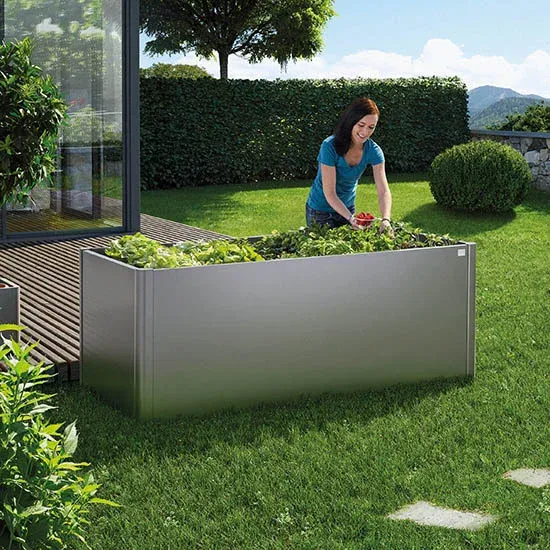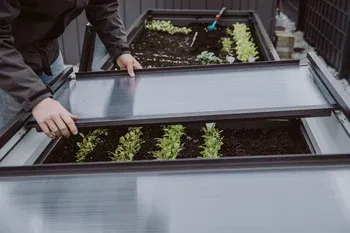7 Questions and Answers About Sowing

Sowing seeds is at the top of every hobby gardener's to-do list in spring and is rightly so popular. Seeds are much cheaper than ready-made young plants, there is a great selection of different plants or flowers and it's also really fun to watch the seeds being sown grow and flourish. It's a long way from sowing to harvesting and to get the most out of it, a few things should be considered right from the start. To ensure that sowing in your own garden or raised bed is a complete success, we have summarised the most important questions and answers here.
What do I need for sowing?
Three things that absolutely every plant needs to grow are warmth, light and water. Warmth and light are provided by the sun. However, until this gains enough strength in spring, the tender little plants should be protected from the low temperatures, especially at night. In a raised bed, you can help yourself with a cold frame extension, in a classic plant bed, warming fleece placed over the germinating seeds at night is an alternative. If the first sowing of the year takes place indoors, for example on a windowsill, seed trays with plastic covers can be useful to optimise heat storage.
The following items are required for sowing: the desired seeds, a suitable container (raised bed, seed tray, flower pot), suitable sowing or propagation soil, water, gloves and small gardening tools such as a planting trowel.
Sowing for beginners
A little tip for all beginners. If you've never heard of sowing before, let us first explain the term: sowing is the process of planting seeds which, with the right care, will grow into tender little plants within a few weeks. This saves you having to buy ready-made young plants, which are usually much more expensive. What's more, by growing your own plants, you accompany each life cycle of a plant and are all the more pleased when you can harvest the fruits of your labour.
When is the best time to sow?
To determine the right time for the first sowing, you should ask yourself two crucial questions: What do I want to sow and where do I want to do it? Depending on whether you are planning to sow indoors or outdoors, you also need to consider the current weather and temperatures. Another thing you should never forget: every seed has its time. That's why it can be useful to consult a sowing calendar. The sowing calendar from Biohort, for example, provides a great overview of the perfect months for sowing in a raised bed. It also gives the ideal germination temperature, germination period, planting distance and sowing depth for many different types of vegetables. Helpful information for sowing is therefore guaranteed.
In principle, the following applies: With an cold frame extension for the raised bed, you can sow certain seeds as early as the end of February/beginning of March, and then start sowing other plants, perennials or flowers from mid-March. From March, for example, peas, lamb's lettuce, potatoes or carrots can be sown. Broccoli, runner beans or courgettes follow a little later.

Sowing in frost
Yes, you read that right. There are plants that can withstand frost and even need it to grow. They are known as cold germinators, typical examples of which are perennials, peonies and wild garlic. Cold germinators should always be sown in autumn, as they need a cold stimulus after sowing in order to germinate.
Sowing in the heat
Just as some plant species can even withstand cold temperatures, sowing is also possible in the heat. Aubergine, garden lettuce and spinach are seeds that can also be sown during the summer months. In warm soil, growth is even much faster than in spring. It is important that the soil is always kept well moist. As soon as the germinating seeds dry out, the gardening fun is over. How often you need to water the seeds per day depends on how sunny or shady the bed is. However, between three and five times a day is definitely necessary when outside temperatures are high. As soon as the soil feels slightly dry, the next watering can is due. Watering in the midday sun should be avoided, as the water evaporates immediately and can burn the leaves.
Sowing on the windowsill: Indoor gardening
Indoor gardening is all the rage. Probably the most typical and most popular indoor seed is cress. Sowing cress seeds on the windowsill is already a popular activity with children in kindergarten. On the one hand, sowing indoors is used to protect sensitive seeds from the cold. On the other hand, indoor gardening is perfect for anyone who doesn't have a balcony or their own garden but still enjoys and has fun working with plants.
For many plants, it is still too cold outdoors in March, April and May, so they are usually sown indoors and only transferred to the bed as young plants. Typical examples of this are tomatoes, chillies and peppers. The windowsill is usually the ideal place for these varieties for the first few weeks after sowing, as the warmth is particularly high through the window glass and it usually also provides sufficient light.
Plan sowing according to the lunar calendar
Many (hobby) gardeners sow according to the lunar calendar and swear by the excellent results that can be achieved. Almost all gardening activities such as sowing, watering, fertilising and weeding can be coordinated with the lunar rhythm and the results observed in your own garden. It is said, for example, that plants such as tomatoes or peppers should be sown when the moon is waxing, whereas plants growing in the soil such as kohlrabi or carrots are suitable for sowing when the moon is waning. If you want to utilise the power of the moon phases for your gardening, it is definitely worth taking a look at the lunar calendar.
How does sowing work?
Sowing itself is actually done quickly. Once you have all the utensils ready, you just need to make sure you sow the seeds to the right depth. This is usually between 0.5 and 2 cm; the exact sowing depth can be found on the seed packet. It is at least as important to keep the soil sufficiently moist. But be careful: please ensure that there is no waterlogging! Once you have placed the seeds in the soil and moistened it sufficiently, you need to wait and be patient. Depending on the germination period, it will take between one and four weeks for the tender seedlings to appear on the surface of the soil.
How to water seeds correctly
When growing plants yourself, it is extremely important to keep the seeds sufficiently moist at all times. When sowing indoors, the first two centimetres of soil should always be well moist. A conventional spray bottle can be used for watering, for example.
When sowing outdoors, it is important that the soil is kept well moist down to the deepest layers of soil and is not just wet on the surface. The classic watering can with spray head should be used here. Why do you need the spray head? If the water jet is too hard, the seeds may be washed away and all the effort will have been in vain. As soon as the first seedlings break through the surface of the soil, it is also preferable to water in the morning. This prevents the tender seedlings from becoming waterlogged overnight and mould from forming.
What does pricking out plants mean?
Pricking is essentially the transplanting of tender plants as soon as they are clearly visible on the surface of the soil after sowing. Gardeners do this so that the individual plants have enough space to grow and can thrive under optimal conditions. For pricking out, it is best to use a pricking stick so that you get the entire plant including the roots. Sounds like a lot of work? Fortunately, not all plants need to be pricked out. Typical plants that need pricking out are fennel, celery and tomatoes.
Why do I need to prick out plants?
When sowing, too many seeds are usually sown in the available space in the bed or container. As soon as they germinate and start to grow, they compete with each other for space, soil nutrients and light. They must therefore be thinned out so that there is sufficient space between the growing plants and each plant can be optimally nourished. The planting distance required by the seed is best read from the seed packaging.
Sowing seeds in raised beds - what do I need to consider?
Gardening in raised beds is becoming increasingly popular and rightly so! It is much easier on the back and more pleasant than spending time hunched over in the garden. Raised beds are therefore an absolute must-have, especially for people with back problems. There are a few simple things to bear in mind to ensure successful sowing in raised beds.
When choosing seeds, always make sure that the respective plants "get along". Radishes, for example, love having lamb's lettuce and strawberries among their neighbours, while tomatoes appreciate the presence of garlic or carrots. Especially in a raised bed, where the roots of different plants inevitably come into contact with each other, you should pay attention to what is sown together.
Another tip for sowing in raised beds: Tall crops such as flowers or tomatoes should ideally be sown in the centre of the bed so that the other plants can still be easily reached and are not deprived of light.
Good luck and have fun sowing!
